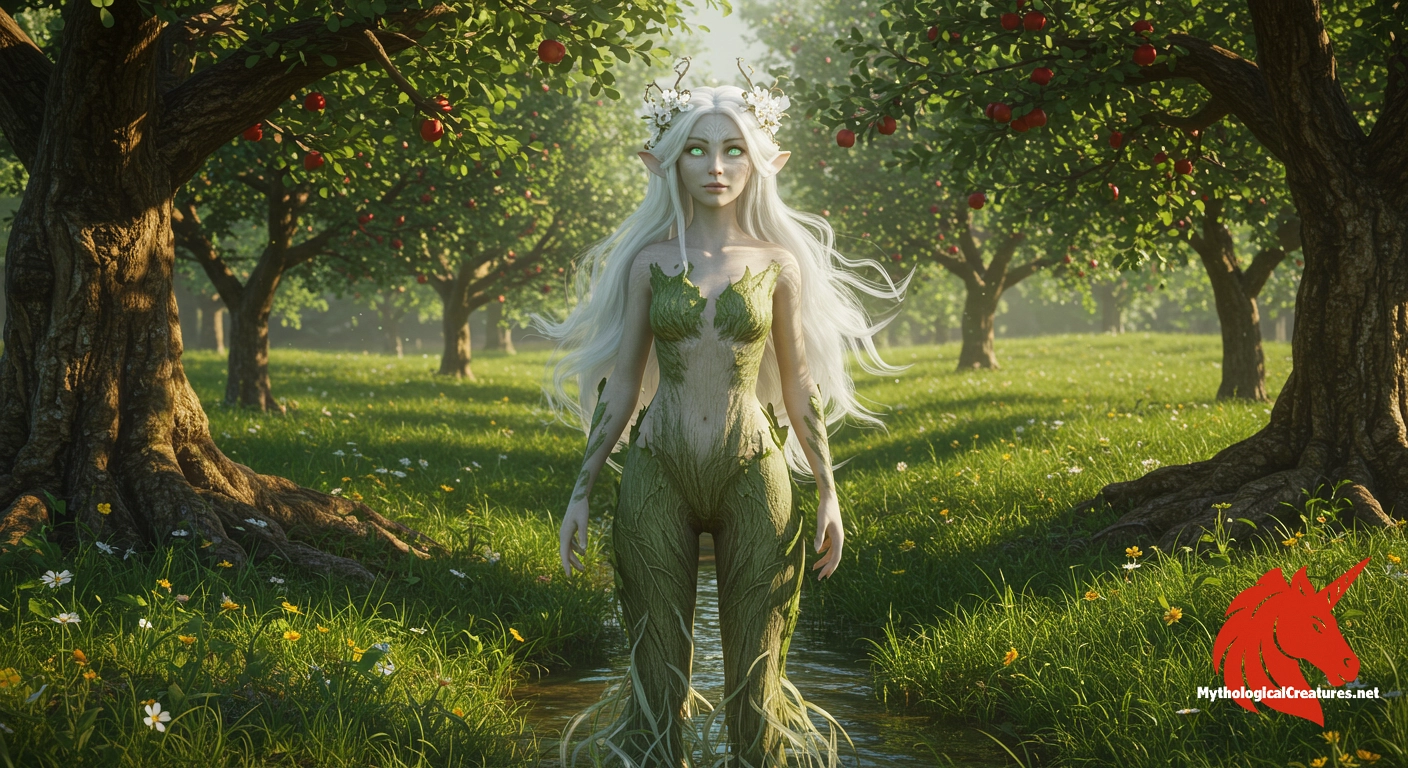Epimeliad: Epimeliads, also known as Epimelides, Meliades, or Maliades, are dryad nymphs in Greek mythology who nurture and protect apple trees as well as flocks of sheep and goats.

Epimeliad
Epimeliad - They embody the nurturing and regenerative aspects of nature in Greek mythology, reflecting a dual role in agriculture and animal care
Origins & First Encounters
The Epimeliads stand as ethereal figures in Greek lore, embodying both the mystique of nature and the bounty of agriculture. Their origins lie deep in the traditions that celebrated the life force of apple orchards and pastoral landscapes. Emerging from the archaic depths of myth, they were revered for their role in nurturing both fruit trees and the flocks that sustained ancient communities. Early attestations hint at their inclusion in the sacred fabric of nature worship, where even minor deities commanded great reverence. Their dual nature, reflected in names that connect them to both trees and herd animals, speaks to the intertwined destiny of plant and animal life. The luminous white hair they bear evokes images of apple blossoms and fresh wool, marking them with an unmistakable signature of purity. Their presence in myth symbolised a harmonious balance between the cultivated and the wild, celebrating nature’s abundance. Over centuries, tales of these nymphs have enriched Greek myth with themes of regeneration and custodianship. Today, their legend persists as an enduring emblem of fertility, inspiring both classical art and modern ecological thought.
Source Texts & Tale Variants
Ancient texts offer a glimpse into the storied past of the Epimeliads, though their mentions are often brief and varied. Their names appear in several fragmented mythological works that celebrate the divine guardians of orchards and flocks. The multiple appellations, such as Epimelides and Maliades, reflect the regional and poetic variations that have come to define their lore. Some literary sources interlace their identity with that of other dryads, adding layers to their dual function in nature. Certain classical accounts evoke them as caretakers of the fabled tree that once safeguarded the Golden Fleece, intertwining their myth with heroic legends. Hellenistic narratives further enriched their character through local cult practices, where oral traditions kept their memory alive. The sparse yet evocative descriptions in early Greek literature laid the foundation for later re-imaginings in art and prose. Over time, varied renditions of their myth have contributed to a mosaic of interpretations that blend fertility, protection, and pastoral care. Modern compilations of myth continue to explore these source variants, highlighting the nymphs’ complexity and subtle influence on ancient cultural identity.
Form & Powers
The Epimeliads are described with a striking physical grace, their hair a shimmering white reminiscent of the delicate petals of apple blossoms and mottled wool from flocks. Their visage is often framed by a natural luminosity, suggesting an otherworldly connection to the vitality of nature. Eyes that reflect the quiet mystery of dappled orchard light and soft, verdant hues enhance their spectral appearance. Their delicate features combine both human elegance and the wild embellishments of the natural world, blurring the lines between artistic ideal and rustic truth. In many depictions, they are adorned with simple, flowing garments that seem woven from the very fibres of the earth, underscoring their organic origins. Some accounts suggest that, when transforming into arboreal entities, their form adopts the texture of bark intermingled with motifs of blossoming fruit. Variations in stature and form are common among these nymphs, symbolising the diversity inherent in nature itself. The interplay between their natural beauty and a subtle hint of otherworldly translucence speaks to their ephemeral existence. Overall, their physical portrayal is a masterful blend of human allure and the raw, enchanting power of the natural environment.
Regional Faces
Across ancient Greece, regional interpretations of the Epimeliads reveal a tapestry of local traditions and cultural nuances. In various Aegean communities, these nymphs were celebrated as the protective spirits of cherished groves and ancient orchards. Small island cults often imbued them with additional attributes, linking their presence to the cyclical rhythms of local harvest celebrations. In parts of Asia Minor, adaptations of their myth saw them as vital custodians not only of fruit-bearing trees but also as healers, whose touch could cure ailments related to agricultural decline. Folklore reimagined them as both nurturing and formidable, protecting the bounty of both the land and the livestock. Local festivals often featured rituals honouring their spirit, thereby intertwining their image with the seasonal cycles of planting and reaping. Artistic renditions in these regions sometimes depicted them adorned with native floral motifs and regional symbols, highlighting their adaptability. The regional diversity in their portrayal reflects a broader pattern of nature deification that accommodates local agricultural practices and environmental idiosyncrasies. As a result, the Epimeliads serve as versatile emblems of nature’s promise across a wide geographical spectrum.
Cultural Parallels
The Epimeliads share intriguing parallels with a host of nature spirits found in other mythological traditions. Their dual role as guardians of fruit and shepherds of flocks draws comparisons to the pastoral deities seen in Roman myth and even in certain Celtic traditions. Figures such as the Roman Bona Dea or the Irish tree spirits echo similar themes of nurturing and natural fertility. Comparable to other dryads in Greek lore, their form embodies the seamless blend of humanity and the sylvan realm. This intermingling of traits is also reminiscent of Renaissance allegories where nature was often personified as a benevolent but powerful force. Cultural intersections emerge when considering how different societies revered the living landscape, with each lending a unique twist to the archetype of the guardian of growth. Their portrayal as both delicate and potent resonates with the universal human appreciation for the interdependence between agriculture and myth. Such cross-cultural similarities reflect a broader, shared heritage in which nature is revered through personification. Overall, these echoes across mythologies underscore the timeless appeal of deities who symbolize the maturation and renewal of life.
Legacy & Modern Evolution
Over the millennia, the image of the Epimeliads has undergone a remarkable transformation while retaining its core essence as a symbol of natural fertility. Early classical depictions emphasised their role as mystical caretakers of orchards and pastoral lands, a theme that has traversed centuries. Their portrayal evolved in the Renaissance period, when art and literature reinterpreted their ethereal beauty and integration with nature. In modern times, they have been embraced by environmental narratives as icons of sustainable living and conservation. Contemporary fantasy literature and digital media often recast them as protector figures, merging ancient symbolism with present-day ecological concerns. Their unique duality, bridging the arboreal and the pastoral, continues to inspire creative reinterpretations in visual arts and storytelling. Modern scholarly works and popular culture alike have solidified their status as emblematic of nature’s fragile yet resilient beauty. The enduring legacy of the Epimeliads is a testament to humanity’s persistent fascination with myth and the natural world. Their myth serves as a bridge between the ancient past and our current quest for environmental harmony, ensuring that their story remains ever relevant.
Interesting Fact
An intriguing aspect of the Epimeliads is their dual responsibility for both fruit trees and flocks, a rare characteristic that highlights the ancient Greek ideal of a harmonious coexistence between agriculture and pastoral life.
Quick Creature Info
Origin:
Features:
Associations:
Our Mythic Legendary Rating:

Also Sometimes Known As:
Habitat:
Supernatural Powers:
Physical Attributes:
Abilities:
Behavior:
Lore:
Related Creatures, Tales or Lore
- DDryads
- NNaiads
- OOreads
References
Discover Another Mythical Legend You May Not Have Heard Of?
Uncover the mysteries of ancient folklore and expand your knowledge of legendary beings from cultures around the world.
Dare to Meet the Tepoztēcatl....
Mythical Disclaimer: The images and data on this site are derived from various historical and literary sources, but we have found that many myths often have multiple versions and interpretations across references, sometimes contradictory. As a result, these creature depictions are artistic interpretations—imaginative blends of folklore, legend, and a dash of AI guesswork. Because creature descriptions vary widely, our illustrations and accompanying information represent our best effort to honor mythology while bridging creative gaps. Enjoy these interpretations—just remember, we've done our best to respect the stories and validate available data, but in the realm of mythology, details often shift, imagination leads the way, and nothing is ever set in stone!
Curated by the Mythological Creatures Team (rev. May 2025)
